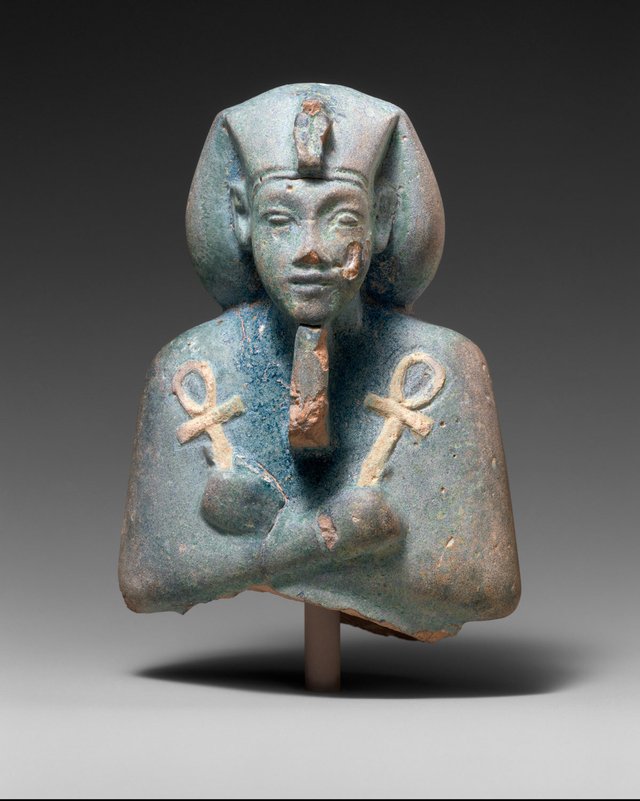The “Shabti of Akhenaten”
Written by Robyn Eggs
The “Shabti of Akhenaten” is dated to 1353 – 1336 B.C.
It represents Egypt, in the Middle Kingdom in what is present day Armana. This art piece is supposedly from the tomb of the pharaoh Akhenaten, who ruled in a “second-flowering” of Egyptian civilization. The pharaoh ruled during a time of wealth and prosperity that came after the re-unification of Egypt. He had elaborate burial chambers prepared for him to include this piece and many more just like it. Over 200 Shabtis were found in Akhenaten’s tomb, inscribed with the pharaoh’s name.
Akhenaten ruled from 1351–1334 b.c.e. and was married to the famous queen, Nefertiti, who was most likely his sister.
Together, these two rulers formed a new religion, which worshiped the sun-god Aten, rather than the traditional god, Amon-Ra. She and Akhenaten were said to have started a cult, which did not take off outside their rule. They built a palace outside the main hub of activity, and dedicated it to this new sun god, Aten.
Made with Faience (a glass-like substance)
this art piece was manufactured during a time when copper was popular, before it became more efficient to use steel. The Egyptians were masters of faience which took ground sandstone and quartz, and combined it with potassium, calcium, magnesium, sodium and copper oxide, which was then tempered.
This fascinating piece made it above the rest in choice, because it is an excellent example of the Ankh,
an Egyptian symbol for life. The Ankh is a fascinating symbol. It was so popular it was adopted by the later period Christians and named the “Crux Ansato”. People remain fascinated by it today. I have been intrigued by its symbolism ever since I took a field trip in grammar school to a museum I cannot remember. There was no stand-alone example of an Ankh to be found in The Metropolitan Museum virtual tour.
The ankh is said to have multiple meanings, none of which are known for a fact.
Originally the terminology for Ankh stemmed from the word for “sandal” but the letters can actually be related to the same in the spelling for life, which is the more popular adaptation. The symbolism of the ankh can be found in mirrors made of copper, said to represent a portal between this world and the afterlife. “Shabti of Akhenaten” is shown (below), as a human figurehead holding an Ankh in each hand, with arms crossed over chest:

“Shabti of Akhenaten”
This art piece was said to have been created in order to take Akhenaten’s place, after death.
This is part of ancient custom, heightened by the wealth of the period. Perhaps Akhenaten meant to be in over 200 places at once, in his next life. Many dedications to the afterlife were made and placed in the ancient burial tombs of pharaohs, besides just the Shabti. It was normal to make elaborate plans for life after death in this early Egyptian civilization.
Much can be understood from this and other art pieces from the middle and new kingdoms of Egypt.
A belief in the afterlife is apparent. Many art pieces found in ancient Egypt from 2000 – 1000 B.C. represent both life and death. The Met Museum’s virtual display from the “Helibrunn Timeline of Art History” for this time period unite in their symbolism.
Statues of pharaohs and queens are manufactured in the outline of the Ankh,
which represents life and possibly a portal to the afterlife. Gods are depicted in these pieces carrying the Ankh and tapping the noses of Pharaohs, possibly to bless them with eternal life. Mirrors were displayed in the shape of the Ankh as well as emblems, amulets and holy storage containers.
Bibliography
- Byrne, Stephen. "The Egyptian Ankh - Facts for Kids." History for Kids. May 2017. http://www.historyforkids.net/egyptian-ankh.html
- Mark, Joshua J. "Faience." Ancient History Encyclopedia. August 11, 2010, accessed May 14, 2017. http://www.ancient.eu/Faience/
- McKay, John P., et al.. A History of World Societies, Volume 1, 10th Edition. (Bedford/St. Martin's, 2015), 46-47.
- Roehrig, Catharine H. “Egypt in the Middle Kingdom (2030–1640 B.C.).” In Heilbrunn Timeline of Art History. New York: The Metropolitan Museum of Art, 2000–. Accessed May 13, 2017. http://www.metmuseum.org/toah/hd/mking/hd_mking.htm
*This block is the sole property of Robyn Eggs and is not for reproduction or republication. Please share this with your friends and neighbors on social media. Copyright 2017.
Follow @robyneggs for more eggsciting works!


Amazeballs!
Wow, i learned something today. Thanks
So glad! :D
I got 100% on this paper, too! :D